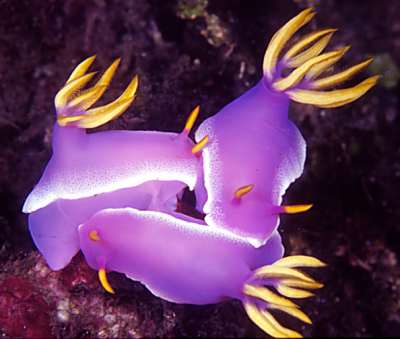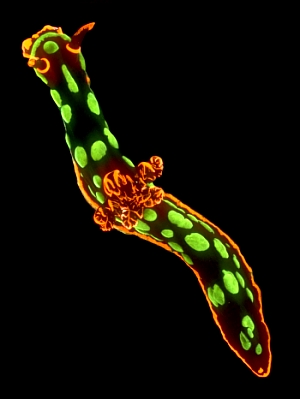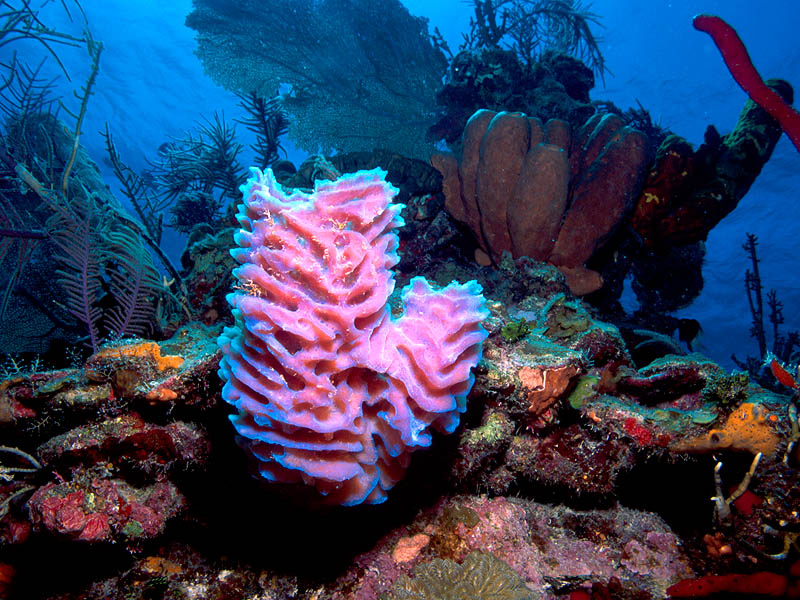
Sea anemones resemble flowers, but they are actually cnidarians, related to coral and jellyfish. They spend their lives rooted to surfaces using a big sticky foot. Their tentacles wave in the currents and catch any pieces of food or animals that pass by.

Sea anemones spend their larval stage as zooplankton floating in the currents. When they reach maturity, they settle on the sea bottom and anchor themselves.

The tentacles of a sea anemone are lined with tiny cells called nematocysts. These cells contain a microscopic spring loaded harpoon. When an unfortunate animal brushes by, the harpoon fires, ensnaring the victim and delivering deadly poison. Once the hapless victim is entangled, the anemone pulls it into its mouth. It digests the food in its stomach and excretes the waste back out through its mouth.

Sea anemones are often sought out as partners for other organisms which use their powerful poison as defense. Hermit crabs will often uproot small sea anemones and stick them on their backs. This serves the anemone well because it is now mobile and can more easily catch bits of food. It also gets to snack on any of the crab's leftovers. The crab benefits by having added protection from predators. Anything trying to eat the crab gets a powerful sting.

Another animal that uses the sea anemone as protection is the clown fish. These fish are adapted to keep the sea anemone from stinging them, and spend their entire lives nestled safely in their deadly tentacles.

Sea anemones come in many shapes, sizes, and colors, and can be found throughout the world, from the cold oceans of North America to tropical Australian coral reefs.

 Oddly enough one of the most deadly animals in the entire ocean is a tiny snail called a cone snail. While it seems comical to even think of a snail as dangerous, let alone lethal, cone snails have some of the most sophisticated and deadly neurotoxins known to man. A cone snail sting can kill a person within minutes of injection.
Oddly enough one of the most deadly animals in the entire ocean is a tiny snail called a cone snail. While it seems comical to even think of a snail as dangerous, let alone lethal, cone snails have some of the most sophisticated and deadly neurotoxins known to man. A cone snail sting can kill a person within minutes of injection. While most snails simply graze on algae, cone snails are active predators. They are fully capable of catching and eating quick and agile fish. These mollusks move just as slowly as other snails, but they pack a hidden weapon. They have a long tube which conceals a deadly harpoon tipped with their powerful venom. They can fire this harpoon with lightning fast accuracy. Their prey is killed almost before even knowing it has been hit. The snail then reels the dead fish into its vacuum-like mouth and swallows it whole.
While most snails simply graze on algae, cone snails are active predators. They are fully capable of catching and eating quick and agile fish. These mollusks move just as slowly as other snails, but they pack a hidden weapon. They have a long tube which conceals a deadly harpoon tipped with their powerful venom. They can fire this harpoon with lightning fast accuracy. Their prey is killed almost before even knowing it has been hit. The snail then reels the dead fish into its vacuum-like mouth and swallows it whole. People are rarely attacked by cone-snails because they do not actively hunt humans. Only about 15 known cone snail related deaths have been reported to date. Most of these incidents occur because people pick up the beautiful shells they see on the ocean floor. When the snail is agitated, it fires its harpoon, and the person often dies within minutes. If you ever see a cone-shaped shell lying on the sand, it's best to just leave it alone.
People are rarely attacked by cone-snails because they do not actively hunt humans. Only about 15 known cone snail related deaths have been reported to date. Most of these incidents occur because people pick up the beautiful shells they see on the ocean floor. When the snail is agitated, it fires its harpoon, and the person often dies within minutes. If you ever see a cone-shaped shell lying on the sand, it's best to just leave it alone.








































